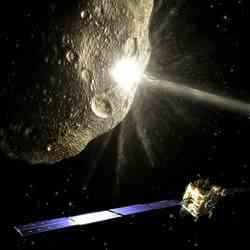
Impacts with very large asteroids are uncommon. Image credit: ESA Click to enlarge
Asteroids don’t hit the Earth often, but when they do, the results can be catastrophic. The European Space Agency is working on several approaches to minimize the chances we’ll make a close encounter with an asteroid. A new mission, called Don Quijote, will launch in 2011 and slam an impactor probe into an asteroid to see what happens. An orbiter spacecraft will remain in orbit around the asteroid and continue to study the aftereffects of the impact. There are now three European teams working on preliminary studies for the potential mission.
If a large asteroid such as the recently identified 2004 VD17 – about 500 m in diameter with a mass of nearly 1000 million tonnes – collides with the Earth it could spell disaster for much of our planet. As part of ESA’s Near-Earth Object deflecting mission Don Quijote, three teams of European industries are now carrying out studies on how to prevent this.
ESA has been addressing the problem of how to prevent large Near-Earth Objects (NEOs) from colliding with the Earth for some time. In 1996 the Council of Europe called for the Agency to take action as part of a “long-term global strategy for remedies against possible impacts”. Recommendations from other international organisations, including the UN and the Organisation for Economic Cooperation and Development (OECD), soon followed.
In response to these and other calls, ESA commissioned a number of threat evaluation and mission studies through its General Studies Programme (GSP). In July 2004 the preliminary phase was completed when a panel of experts appointed by ESA recommended giving the Don Quijote asteroid-deflecting mission concept maximum priority for implementation.
Now it is time for industry to put forward their best design solutions for the mission. Following an invitation to tender and the subsequent evaluation process, three industrial teams have been awarded a contract to carry out the mission phase-A studies. :
– a team with Alcatel Alenia Space as prime contractor includes subcontractors and consultants from across Europe and Canada; Alcatel Alenia Space developed the Huygens Titan probe and is currently working on the ExoMars mission
– a consortium led by EADS Astrium, which includes Deimos Space from Spain and consultants from several European countries, brings their experience of working on the design of many successful ESA interplanetary missions such as Rosetta, Mars and Venus Express
– a team led by QinetiQ (UK), which includes companies and partners in Sweden and Belgium, draws on their expertise in mini and micro satellites including ESA’s SMART-1 and Proba projects
This month the three teams began work and a critical milestone will take place in October when the studies will be reviewed by ESA with the support of an international panel of experts. The results of this phase will be available next year.
The risk is still small however, and may decrease even further when new observations are carried out. Still, if this or any other similar-sized object, such as 99942 Apophis, an asteroid that will come close enough to the Earth in 2029 to be visible to the naked eye, collided with our planet the energy released could be equivalent to a significant fraction of the world’s nuclear arsenal, resulting in devastation across national borders.
Luckily, impacts with very large asteroids are uncommon, although impacts with smaller asteroids are less unlikely and remote in time. In 1908 an asteroid that exploded over Siberia devastated an unpopulated forest area of more than 2000 km2; had it arrived just a few hours later, Saint Petersburg or London could have been hit instead.
Asteroids are a part of our planet’s history. As anyone visiting the Barringer Meteor Crater in Arizona, USA or aiming a small telescope at the Moon can tell, there is plenty of evidence that the Earth and its cosmic neighbourhood passed through a period of heavy asteroid bombardment. On the Earth alone the remains of more than 160 impacts have been identified, some as notorious as the Chicxulub crater located in Mexico?s Yucatan peninsula, believed to be a trace of the asteroid that caused the extinction of the dinosaurs 65 million years ago.
Collisions have shaped the history of our Solar System. Because asteroids and comets are remnants of the turbulent period in which the planets were formed, they are in fact similar to ‘time capsules’ and carry a pristine record of those early days. By studying these objects it is possible to learn more about the evolution of our Solar System as well as ‘hints’ about the origins of life on Earth.
Comet 67P/Churyumov-Gerasimenko is one of these primitive building blocks and will be visited by ESA’s Rosetta spacecraft in 2014, as a part of a very ambitious mission – the first ever to land on a comet. Rosetta will also visit two main belt asteroids (Steins and Lutetia) on its way to comet 67P/Churyumov-Gerasimenko. The mission will help us to understand if life on Earth began with the help of materials such as water and organisms brought to our planet by ‘comet seeding’.
ESA’s Science programme is already looking at future challenges, and its Cosmic Vision 2015-2025 plan has identified an asteroid surface sample return as one of the key developments needed to further our understanding of the history and composition of our Solar System.
Asteroids and comets are fascinating objects that can give or take life on a planetary scale. Experts around the world are putting all their energy and enthusiasm into deciphering the mysteries they carry within them.
With an early launch provisionally scheduled for 2011, Don Quijote will serve as a ‘technological scout’ not only to mitigate the chance of the Earth being hit by a large NEO but also for the ambitious journeys to explore our solar system that ESA will continue to embark upon. The studies now being carried out by European industry will bring the Don Quijote test mission one step nearer.
Original Source: ESA Portal
